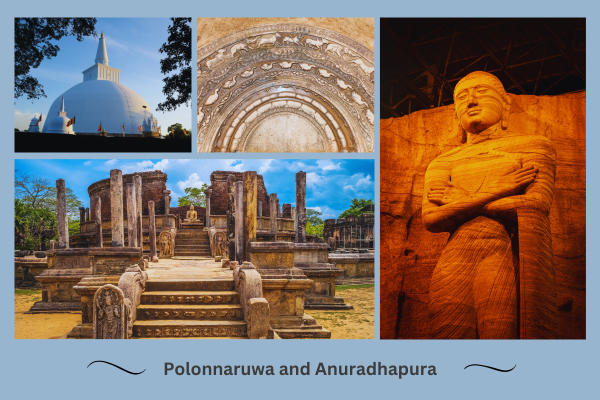Ancient Cities of Sri Lanka: A Look into Polonnaruwa and Anuradhapura – By Malsha – eLanka

Sri Lanka, an island steeped in history, boasts a rich heritage reflected in its ancient cities. Among these, Polonnaruwa and Anuradhapura stand out as iconic centers of culture, spirituality, and governance. These cities, both UNESCO World Heritage Sites, encapsulate the grandeur of Sri Lanka’s ancient kingdoms.
Anuradhapura: The First Capital of Sri Lanka
Dating back to the 4th century BCE, Anuradhapura was the first established capital of ancient Sri Lanka and thrived for over 1,300 years. Renowned for its Buddhist heritage, the city became the spiritual heart of the island. Its well-preserved ruins offer a glimpse into an advanced civilization that excelled in irrigation, architecture, and governance.
Key Highlights:
- Sacred Bodhi Tree (Jaya Sri Maha Bodhi): Believed to be the oldest historically recorded tree in the world, this sapling of the original Bodhi tree under which the Buddha attained enlightenment is a focal point for Buddhist devotees.
- Ruwanwelisaya Stupa: An architectural marvel, this giant stupa is one of the most significant landmarks of Buddhist devotion.
- Abhayagiri Monastery: Once a thriving center for Buddhist learning, this monastery complex showcases intricate carvings and ancient engineering.
- Irrigation Systems: The Kala Wewa and Tissa Wewa reservoirs demonstrate the ingenuity of ancient Sri Lankan hydraulic engineering.
Polonnaruwa: The Second Great Capital
Following the fall of Anuradhapura in the 11th century, Polonnaruwa became the capital, marking a new era in Sri Lankan history. It flourished under King Parakramabahu I, who transformed it into a center of culture, religion, and trade. The city is known for its fusion of Sinhalese and South Indian architectural styles.
Key Highlights:
- Gal Vihara: A collection of stunning rock-cut Buddha statues, including a reclining Buddha, which remains a masterpiece of Sinhalese sculpture.
- Parakrama Samudra: A massive man-made reservoir symbolizing King Parakramabahu’s vision of sustainable water management.
- Vatadage: This circular relic house, adorned with intricate carvings, is a prime example of ancient Sri Lankan craftsmanship.
- Lankatilaka Temple: A towering brick structure that housed a colossal standing Buddha statue, showcasing the grandeur of Polonnaruwa’s religious architecture.
Cultural and Spiritual Significance
Both Anuradhapura and Polonnaruwa were epicenters of Buddhism, playing pivotal roles in the dissemination of the religion across Asia. The stupas, monasteries, and temples in these cities were not merely places of worship but also hubs for education and art.
Exploring the Ancient Cities Today
Visiting these ancient cities is like stepping back in time. The ruins, though weathered by centuries, still evoke awe and reverence. Travelers can explore:
- Cycling tours in Polonnaruwa, offering a relaxed way to experience the sprawling ruins.
- Guided visits in Anuradhapura, which delve deep into the city’s historical and spiritual significance.
- Wildlife spotting, as both cities are near national parks like Minneriya and Wilpattu, where elephants and other wildlife roam freely.
Preserving the Legacy
The preservation of these sites is vital for maintaining Sri Lanka’s historical narrative. Ongoing archaeological efforts and UNESCO recognition have helped safeguard these treasures for future generations.
Conclusion
Polonnaruwa and Anuradhapura stand as testaments to Sri Lanka’s rich history and cultural heritage. They are not just relics of the past but enduring symbols of the island’s identity and ingenuity. For history enthusiasts, pilgrims, and curious travelers, these ancient cities offer a profound journey into the heart of Sri Lanka’s glorious past.



















